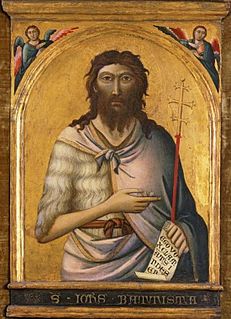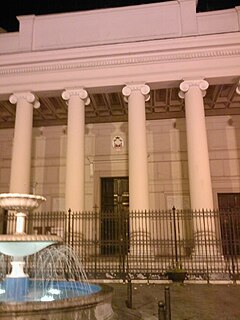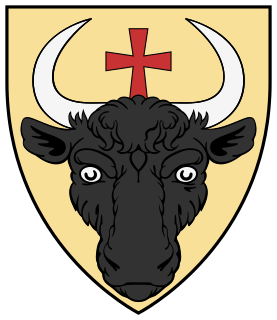
The Orsini family is an Italian noble family that was one of the most influential princely families in medieval Italy and Renaissance Rome. Members of the Orsini family include three popes: Celestine III (1191–1198), Nicholas III (1277–1280), and Benedict XIII (1724–1730). In addition, the family membership includes 34 cardinals, numerous condottieri, and other significant political and religious figures.

Strongoli is a comune and town with a population of over 6000 people in the province of Crotone, in Calabria, southernmost Italy.

Cockersand Abbey is a former abbey near Cockerham in the City of Lancaster district of Lancashire, England. It was founded before 1184 as the Hospital of St Mary on the marsh belonging to Leicester Abbey. It was refounded by the Cambro-Norman magnate, Theobald Walter, 1st Baron Butler as a Premonstratensian priory. It was subsequently elevated to an abbey in 1192. It also continued as a hospital.

Jacopo del Casentino was an Italian painter, active mainly in Tuscany in the first half of the 14th century.

JacopoTiepolo, also known as Giacomo Tiepolo, was Doge of Venice from 1229 to 1249. He had previously served as the first Venetian Duke of Crete, and two terms as podestà in Constantinople. During his first term, following the capture and mysterious end of Peter of Courtenay, Tiepolo acted as de facto ruler of the Latin Empire, negotiating treaties on behalf of the Empire with Egypt and the Seljuk Turks.

Santa Maria dei Carmini, also called Santa Maria del Carmelo and commonly known simply as the Carmini, is a large Roman Catholic church in the sestiere, or neighbourhood, of Dorsoduro in Venice, northern Italy. It nestles against the former Scuola Grande di Santa Maria del Carmelo, also known as the Scuola dei Carmini. This charitable confraternity was officially founded in 1597, and arose from a lay women's charitable association, the Pinzocchere dei Carmini. The members of this lay group were associated as tertiaries to the neighbouring Carmelite monastery. They were responsible for stitching the scapulars for the Carmelites.
The Nikolić was Bosnian medieval noble family from Hum (Herzegovina). The family's estate was in Popovo Polje. They were of minor importance, serving under Grand Dukes of Bosnia and noble families of Hranić and Kosača, lords of Hum and later Herzegovina.

The Diocese of Acerra is a Roman Catholic ecclesiastical territory in Campania, southern Italy, existing since the 11th century. It is a suffragan of the Archdiocese of Naples.

Pietro Vesconte was a Genoese cartographer and geographer. A pioneer of the field of the portolan chart, he influenced Italian and Catalan mapmaking throughout the fourteenth and fifteenth centuries. He appears to have been the first professional mapmaker to sign and date his works regularly.

The Tudisi waere a Ragusan noble family, which produced people such as distinguished diplomat Martholus de Tudisio and merchant Give de Tudisio in the 14th century. The basis of their economy was ties with the Republic of Venice in the 14th and 15th centuries. They were among the eleven smallest houses in the 15th century. After 1808, with the French occupation and division of the Ragusan nobility into two groups, the family joined the Salamancanists, along with the Bassegli, Benessa, Bonda, Buća, Giorgi-Bona, Gradi, Ragnina and Resti, while Gondola, Palmotta, Proculo were Sorbonnists; the rest of Ragusan nobility had branches, more or less, in both groups. The family moved to Venice, as did many of the other Ragusan patrician families.

Karauli State was a princely state in India from 1348 to 1949. It is located in the Braj region. Karauli city was the capital while Mandrayal or Mandrail was another important town.
The Spata family, was an Albanian noble family active in the 14th, 15th and 16th centuries, initially as Venetian vassals and later as Ottoman vassals. The family's progenitors were the brothers John Spata and Sgouros Spata.
The Radagli were a noble family of the Republic of Venice in the 16th century and the Republic of Ragusa since 1666.

Dandolo was a patrician family of the Republic of Venice, which produced four Doges of Venice. The progenitor of the family was a merchant named Domenico. The family became more successful by the beginning of the 12th century.
Szabari or Szabary was the name of a short-lived lesser noble family in Zala County, Kingdom of Hungary in the 14th century.

Csányi or Csány was a noble family in the Kingdom of Hungary, which first appeared in the early 14th century and had estates and villages mostly in Zala County.
Báncsa or Bancsa, also incorrectly Vancsa or Vancza, was the name of a gens in the Kingdom of Hungary.












